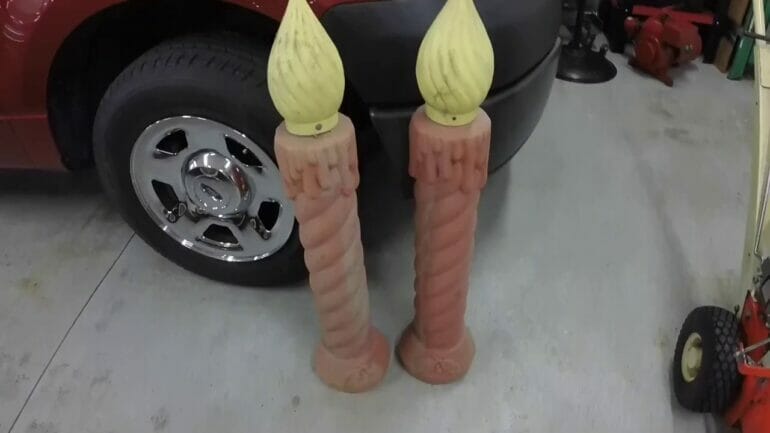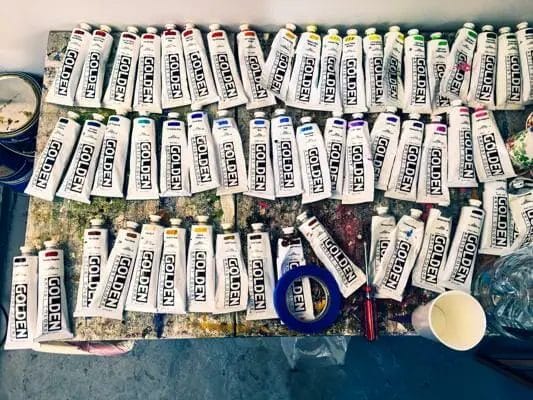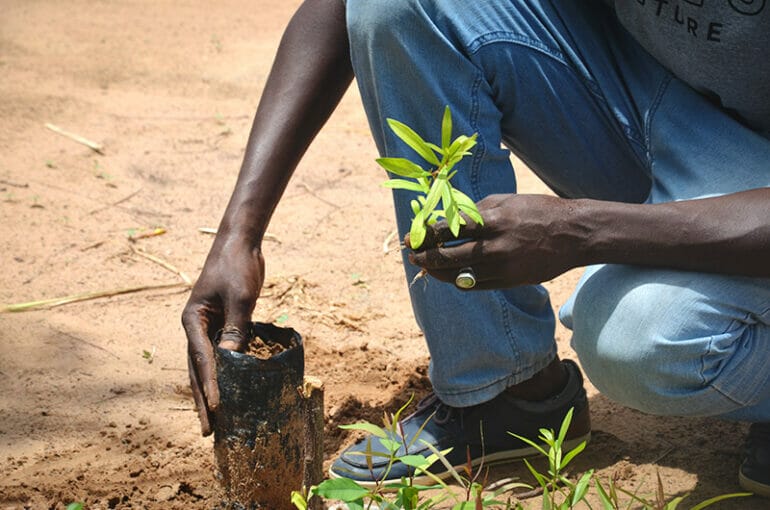When it comes to restoring blow molds, choosing the right paint is crucial for achieving the desired results.
One popular option is acrylic paint, which provides excellent coverage and adhesion to plastic surfaces.
Another great choice is enamel paint, known for its durability and resistance to chipping and fading.
For a more vibrant and glossy finish, consider using spray paint, which can help you achieve a smooth and even coat.
Regardless of the type of paint you choose, make sure to clean and prime the surface beforehand for best adhesion and longevity.
With the right paint choice and proper preparation, you can bring new life to your blow molds and enjoy their beauty for years to come.

Choosing the Right Paint for Blow Mold Restoration
Blow mold restoration is a process that involves rejuvenating and restoring the appearance of plastic blow molds. Whether you are a hobbyist or a professional in the blow molding industry, choosing the right paint is crucial to achieve a successful restoration. In this section, we will discuss the factors to consider when selecting paint for blow mold restoration.
1. Type of Paint
When it comes to restoring blow molds, there are different types of paint that you can choose from. The most common types are acrylic paint, enamel paint, and spray paint. Each type has its own advantages and disadvantages, so it’s important to consider your specific needs and preferences.
– Acrylic paint: Acrylic paint is water-based and dries quickly. It is easy to work with and provides a smooth and durable finish. It is also available in a wide range of colors, making it ideal for blow mold restoration.
– Enamel paint: Enamel paint is oil-based and provides a glossy and durable finish. It is known for its excellent adhesion and resistance to chipping and fading. However, it requires longer drying time and may emit strong odors during application.
– Spray paint: Spray paint is convenient and allows for even coverage. It is available in various finishes, such as matte, satin, and gloss. However, it may not provide as durable a finish as traditional brush-on paints.
2. Color Matching
When restoring blow molds, it’s important to consider the original color of the mold. If you are aiming for an accurate restoration, you will need to find a paint color that matches the original as closely as possible. This can be challenging, especially for older blow molds where the original color may have faded or changed over time.
One approach is to bring a small piece of the blow mold to a paint store or use color-matching technology to find the closest match. Another option is to consult online communities or forums where blow mold enthusiasts share information and resources related to restoration.
3. Surface Preparation
Proper surface preparation is essential for a successful blow mold restoration. Before applying the paint, make sure to clean the mold thoroughly to remove any dirt, grime, or old paint. Depending on the condition of the mold, you may need to sand or prime the surface to ensure better paint adhesion.
It’s also important to consider the material of the blow mold. Some blow molds are made of high-density polyethylene (HDPE), while others are made of medium-density polyethylene (MDPE) or other types of plastic. Different plastics may require different surface preparation techniques and primers, so be sure to follow the manufacturer’s recommendations.
4. Protective Coating
To ensure the longevity of your blow mold restoration, consider applying a protective coating over the paint. This can help protect the mold from UV rays, moisture, and other environmental factors that can cause the paint to fade or deteriorate over time.
There are various types of clear coatings available, such as clear spray lacquer or clear enamel. Choose a coating that is compatible with the type of paint you are using and follow the application instructions carefully.
5. Test and Evaluate
Before applying the paint to the entire blow mold, it’s a good practice to do a test application on a small, inconspicuous area. This will allow you to evaluate the color, adhesion, and overall appearance of the paint before committing to the entire restoration.
It’s also important to consider the weather conditions during the restoration process. Extreme temperatures or high humidity can affect the drying and adhesion of the paint, so choose a suitable time and environment for your project.
Choosing the right paint for blow mold restoration is essential to achieve a successful outcome. Consider the type of paint, color matching, surface preparation, protective coating, and conducting tests before committing to the full restoration. By following these guidelines, you can bring new life to your blow molds and enjoy their vibrant colors for years to come.

Top Paint Recommendations for Restoring Blow Molds
Restoring blow molds can be a rewarding and enjoyable hobby for many enthusiasts. These vintage holiday decorations hold sentimental value for many people and restoring them to their former glory can bring back cherished memories. One important aspect of the restoration process is choosing the right paint to ensure a durable and professional-looking finish. In this section, we will explore the top paint recommendations for restoring blow molds.
1. Acrylic Paint
Acrylic paint is a popular choice for restoring blow molds due to its versatility and ease of use. It adheres well to the surface of the molds and provides a smooth and even finish. Acrylic paint is available in a wide range of colors, making it easy to match the original color of the blow mold. It also dries quickly, allowing for multiple coats to be applied in a short period of time. Additionally, acrylic paint is water-based, which means it can be easily cleaned up with water and soap.
2. Enamel Paint
Enamel paint is another great option for restoring blow molds. It provides a glossy and durable finish that can withstand the elements and outdoor conditions. Enamel paint adheres well to the surface of the molds and provides excellent coverage. It is available in a variety of colors and finishes, allowing for customization and creativity in the restoration process. Enamel paint usually requires a longer drying time compared to acrylic paint, but the end result is well worth the wait.
3. Spray Paint
Spray paint is a convenient option for restoring blow molds, especially for larger pieces. It provides an even and smooth finish, and the aerosol can allows for easy application. Spray paint is available in a wide range of colors, including metallic and specialty finishes. It is important to choose a spray paint that is suitable for outdoor use to ensure the longevity of the restored blow mold. Before applying the spray paint, it is recommended to clean and prepare the surface of the mold to ensure proper adhesion.
4. Epoxy Paint
Epoxy paint is a durable and long-lasting option for restoring blow molds. It provides a hard and protective coating that can withstand harsh weather conditions. Epoxy paint is resistant to chipping, peeling, and fading, ensuring that the restored blow mold will maintain its vibrant appearance for years to come. It is important to follow the manufacturer’s instructions when using epoxy paint, as proper surface preparation and application techniques are essential for optimal results.
5. Oil-Based Paint
Oil-based paint is a traditional option for restoring blow molds. It provides a smooth and durable finish that can withstand outdoor conditions. Oil-based paint offers excellent coverage and is available in a variety of colors. However, it does require longer drying times compared to other paint options. It is important to ensure proper ventilation when using oil-based paint, as the fumes can be strong. Additionally, cleaning up oil-based paint requires the use of solvents such as mineral spirits or paint thinner.
In summary, choosing the right paint for restoring blow molds is crucial for achieving a professional and long-lasting finish. Acrylic paint, enamel paint, spray paint, epoxy paint, and oil-based paint are all excellent options to consider. Each type of paint has its own unique characteristics and advantages, so it is important to choose the one that best suits your preferences and the specific needs of your blow mold restoration project. With the right paint and proper application techniques, you can breathe new life into your vintage blow molds and enjoy their beauty for many more years to come.

Restoring Blow Molds: Which Paint Works Best?
If you are a fan of vintage holiday decorations, chances are you have come across blow molds. These colorful and whimsical plastic figures were popular in the mid-20th century and are still enjoyed by collectors today. However, over time, the paint on blow molds can fade, chip, or peel, leaving them looking worn and tired.
If you want to restore your blow molds to their former glory, one of the most important steps is choosing the right paint. In this section, we will explore the different types of paint that work best for restoring blow molds and provide some tips for achieving professional-looking results.
Epoxy Paint
Epoxy paint is a popular choice for restoring blow molds, thanks to its durability and ability to adhere well to plastic surfaces. This type of paint creates a tough and resilient finish that can withstand the elements and resist fading. Epoxy paints are available in a variety of colors, making it easy to find the perfect shade for your blow molds. When using epoxy paint, it is important to prepare the surface properly by cleaning and sanding it to ensure good adhesion.
Aerosol Spray Paint
Aerosol spray paint is another option for restoring blow molds. This type of paint is convenient to use and provides a smooth and even finish. It is available in a wide range of colors and finishes, allowing you to achieve the desired look for your blow molds. When using spray paint, it is important to apply thin and even coats to prevent drips and ensure proper coverage. Additionally, it is recommended to use a primer designed for plastic surfaces to enhance adhesion.
Acrylic Paint
Acrylic paint can also be used to restore blow molds. This type of paint is easy to work with and dries quickly, allowing for faster project completion. Acrylic paints are available in a wide range of colors and finishes, giving you plenty of options for customizing your blow molds. When using acrylic paint, it is recommended to seal the finished project with a clear coat to protect the paint from fading or peeling.
Specialty Paints
There are also specialty paints available specifically designed for plastic surfaces, including blow molds. These paints often have added adhesion promoters and flexible properties, making them ideal for restoring and rejuvenating plastic decorations. These paints come in various forms, such as brush-on or spray-on, and offer excellent coverage and durability.
Tips for Achieving Professional Results
When painting blow molds, it is important to follow some tips to achieve professional-looking results:
- Clean the surface: Before applying any paint, clean the blow mold thoroughly to remove dirt and debris. This ensures good adhesion and a smooth finish.
- Sand the surface: If the blow mold has any rough or peeling areas, gently sand them to create a smooth surface for the paint to adhere to.
- Use light coats: Instead of applying a thick layer of paint, use multiple light coats to achieve an even finish. This helps prevent drips and allows for better control over the final look.
- Allow proper drying time: Follow the manufacturer’s instructions regarding drying time between coats and before handling the blow mold. This ensures that the paint fully cures and provides maximum durability.
- Protect the paint: Once the blow mold is painted and dry, consider applying a clear coat or sealant to protect the paint from fading or chipping over time.
In summary, restoring blow molds can be a fun and rewarding project. Choosing the right paint is essential for achieving long-lasting and professional-looking results. Whether you opt for epoxy paint, aerosol spray paint, acrylic paint, or specialty paints, following proper preparation and painting techniques will help ensure the success of your restoration project. With a little time and effort, you can bring your beloved blow molds back to life and enjoy their vibrant colors for years to come.
The Ideal Paint for Blow Mold Restoration
When it comes to restoring blow molds, choosing the right paint can make all the difference. Whether you are working on a vintage blow mold or a newer one, finding the ideal paint is crucial for achieving a beautiful and long-lasting result. In this section, we will explore the characteristics to look for in the ideal paint for blow mold restoration.
1. Weather Resistance
Blow molds are often placed outdoors, making them vulnerable to various weather conditions. Therefore, it is essential to choose a paint that can withstand the elements. Look for paints that offer excellent weather resistance, such as acrylic or urethane-based paints. These types of paints provide a protective barrier against UV rays, moisture, and temperature changes, ensuring that your restored blow mold will remain vibrant and intact for years to come.
2. Adhesion
One of the most critical factors to consider when choosing a paint for blow mold restoration is adhesion. The paint must adhere well to the surface of the blow mold to prevent peeling, chipping, or flaking. Look for paints specifically designed for use on plastic surfaces, as they often have superior adhesion properties. Additionally, consider using a bonding primer before applying the topcoat to promote better adhesion.
3. Color Matching
Blow molds come in a variety of colors and designs, making color matching a vital aspect of restoration. The ideal paint for blow mold restoration should offer a wide range of colors and the ability to match the original shade accurately. Look for paints that provide color swatches or samples to ensure that you can achieve a seamless color match for your blow mold.
4. Durability
A restored blow mold should be able to withstand daily wear and tear. Therefore, durability is a crucial characteristic to consider when selecting the paint. Look for paints that have excellent scratch resistance and are tough enough to resist fading, cracking, and peeling. This will ensure that your restored blow mold can be enjoyed for many years without the need for frequent touch-ups or repairs.
5. Easy Application
Whether you are a seasoned restorer or a beginner, choosing a paint that is easy to apply can save you time and effort. Look for paints that offer smooth and even coverage, allowing for seamless application with brushes or spray guns. Additionally, consider the drying time of the paint, as a quicker drying paint can speed up the restoration process.
6. Safety
When working with paints, safety should always be a priority. Look for paints that are non-toxic and environmentally friendly. Water-based paints are a great option as they have minimal fumes and are easy to clean up. Additionally, consider wearing appropriate protective gear, such as gloves and a mask, when working with any type of paint.
In summary, choosing the ideal paint for blow mold restoration involves considering factors such as weather resistance, adhesion, color matching, durability, easy application, and safety. By selecting a paint that excels in these areas, you can ensure that your restored blow mold will look stunning and withstand the test of time.
FAQs
Q: What paint should I use when restoring blow molds?
For restoring blow molds, it’s recommended to use acrylic enamel spray paint. This type of paint adheres well to plastic surfaces and provides a durable finish. Make sure to clean and prep the surface before painting, and apply multiple thin coats for better coverage.
Q: Can I use regular spray paint on blow molds?
Using regular spray paint on blow molds may not give satisfactory results. Regular spray paint may not adhere well to plastic surfaces and may chip or peel off easily. It’s best to use acrylic enamel spray paint specifically designed for plastic materials to ensure a long-lasting finish.
Q: How should I prepare the blow molds before painting?
Before painting blow molds, it’s important to clean them thoroughly to remove any dirt or debris. You can use mild soap and water or a plastic cleaner to clean the surface. Once clean, lightly sand the blow molds to create a rough surface that will help the paint adhere better. Finally, wipe off any dust or residue before applying the paint.
Conclusion
In conclusion, when restoring blow molds, choosing the right paint is crucial for achieving the desired results. By considering factors such as durability, flexibility, and color accuracy, you can ensure a successful restoration project. Acrylic paints are a popular choice as they offer excellent adhesion, versatility, and long-lasting finish. Additionally, using a primer designed specifically for plastic surfaces can enhance the paint’s adherence and durability. It is important to follow the manufacturer’s instructions and apply multiple thin coats to achieve a smooth and even finish. Remember, proper preparation, including cleaning and sanding the surface, will also contribute to the success of your blow mold restoration.
